
Asthma is one of the most common chronic diseases worldwide, and its prevalence--particularly among children--is increasing in many countries.1,2 In 1997, an estimated 9.6% of persons in the United States had asthma (Table 1).3

Asthma is one of the most common chronic diseases worldwide, and its prevalence--particularly among children--is increasing in many countries.1,2 In 1997, an estimated 9.6% of persons in the United States had asthma (Table 1).3

A menagerie of zoonotic diseases.

A 10-year-old girl has had a worsening rash for 1 week. The mildly pruritic, nontender eruption initially appeared on the child's thighs and then spread to the arms and face. The child's right hand, feet, and ankles have been swollen for the past 4 days, which has made ambulation intermittently painful.

A verrucous birthmark, a rash at the commissure of the lips, proximalnail changes--can you identify the disorders pictured here?

The patient is a 12-year-old Hispanic boy with hemophilia A (factor VIII deficiency) and high Bethesda unit factor VIII inhibitor who presented to a clinic after 4 days of abdominal pain and clear, nonbilious vomiting. Viral gastroenteritis had been diagnosed, and the boy was given rabeprazole and promethazine, which failed to resolve symptoms. The patient was hospitalized when he became unable to tolerate oral fluids; his urinary output decreased. He denied fever, diarrhea, hematemesis, hematochezia, and melena.
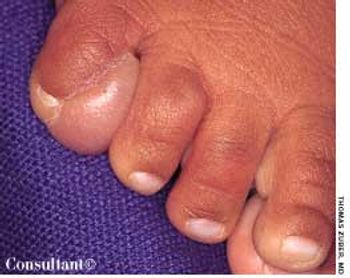
An enlarging mass was noted on the dorsum of the right fifth toe of a 2-month-old boy during a well-child examination. The firm, immobile mass measured approximately 1 cm in diameter. A congenital abnormality was suspected; the patient was referred to a plastic surgeon for consultation.
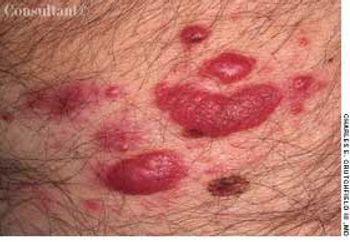
A 51-year-old man presented with red, mildly pruritic papulonodules that had erupted on his face approximately 5 weeks earlier. The clinical appearance suggested cutaneous lymphoid hyperplasia.
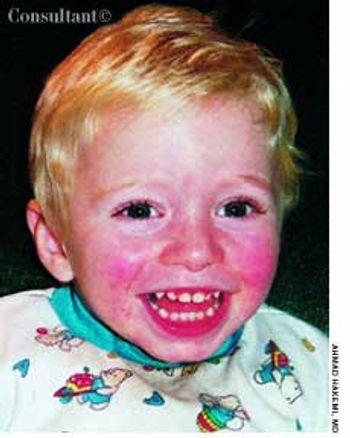
The parents of a 2-year-old sought treatment for a rash on their son's face. The child had had a low-grade fever for 3 days before the rash erupted. An intermittent lace-like rash was beginning to develop on the extremities. The patient was otherwise asymptomatic.
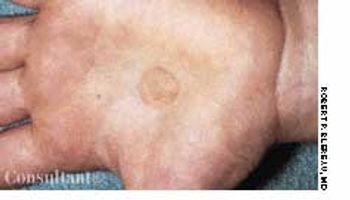
Identical circular, chocolate-colored spots developed on a 4-year-old boy's palms 2 weeks ago, according to the child's mother. The sharply demarcated, macular lesions were asymptomatic.
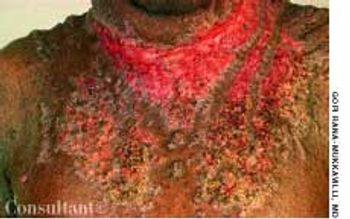
Pain and pruritus of the neck and upper chest began to bother a 43-year-old woman several hours after she put on a new copper necklace. Vigorous scratching of the affected area caused excoriation of the skin, which can mask the eruption and complicate diagnosis.
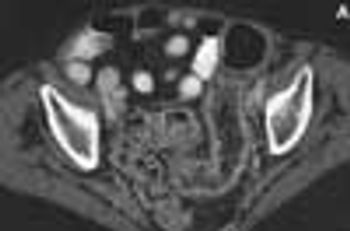
Following mechanical bowel preparation and prophylactic antibiotic therapy, a 59-year-old man underwent transanal excision of a villous adenoma of the distal rectum. Two weeks after discharge, he returned with a temperature of 38.9°C (102°F), abdominal pain, and diarrhea.
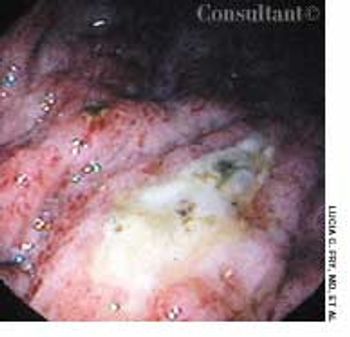
A 72-year-old man presented after several months of dyspepsia and 1 day of hematemesis. He was not taking NSAIDs.
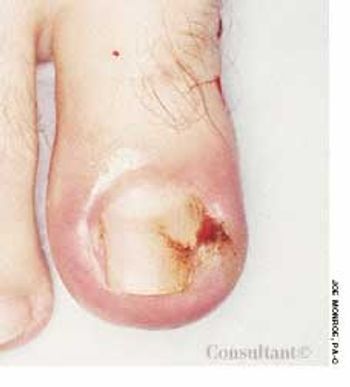
A 15-year-old experienced pain in her toe, particularly when pressure was applied to the foot. An ingrown toenail was the cause of her discomfort.
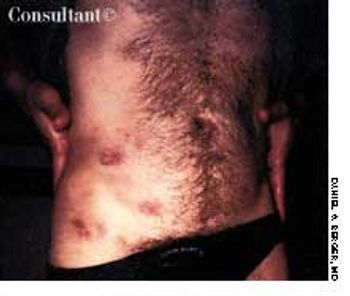
A 39-year-old man with HIV infection was being treated with antiretroviral therapy. He now sought help for multiple 2- to 3-cm violaceous papules on his right hip and the right lower abdominal area. A biopsy specimen showed intense, atypical lymphocytoid and monocytoid cells with prominent nucleoli, hyperchromatism, and bruised nuclei.
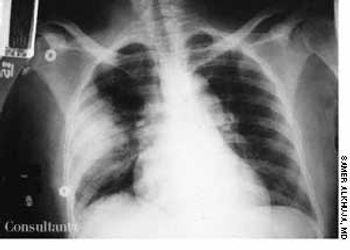
A febrile 65-year-old woman who had suffered a new-onset seizure was brought to the emergency department. The patient-a cigarette smoker-was not coughing and had neither chest pain nor a significant medical history. Her temperature was 39.4°C (103°F). She had nuchal rigidity and Kernig's and Brudzinski's signs of meningeal irritation. Lung auscultation revealed signs of right middle lung consolidation. Her white blood cell count was 1,200/µL. A chest film, seen here, showed a masslike density in the right midlung.
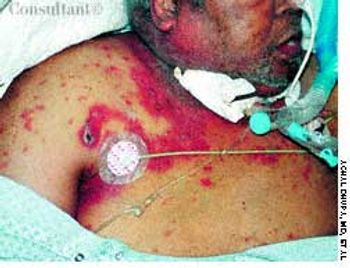
A 72-year-old morbidly obese man who had diabetes mellitus was admitted to the hospital from a nursing home with a fever of 4 days' duration. A tracheostomy had been performed 3 months earlier for respiratory failure. The patient was being treated with corticosteroids for chronic obstructive pulmonary disease.
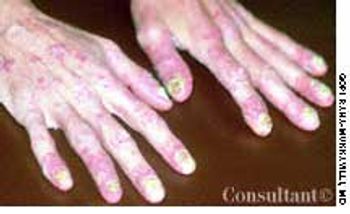
A 38-year-old woman had become increasingly depressed by worsening psoriasis in conjunction with a flare of arthritis in her hands and fingers. The patient complained that she could not function optimally and that her quality of life had diminished.
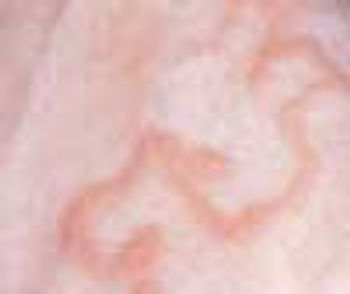
The foot of a 10-year-old boy demonstrates the unique wandering cutaneous lesions of creeping eruption, or cutaneous larva migrans. This disorder is caused by skin penetration of hookworm larvae. It is seen in the southeastern United States and tropical and subtropical regions throughout the world.
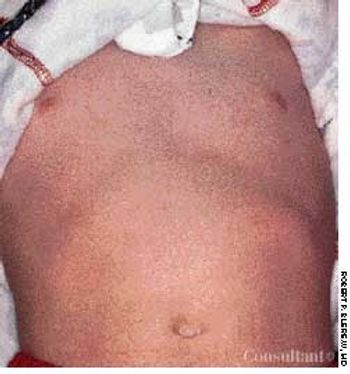
Encountered rarely these days, scarlet fever is believed to be caused by sensitization to an erythrogenic toxin produced by strains of group A β-hemolytic streptococci. Thus, previous exposure to the toxin is necessary for development of the rash seen here-fine, sandpaper-like, and papular on an erythematous background. It usually begins on the trunk and spreads over the entire body within hours or days. Scarlet fever is unusual in infancy, possibly because of maternal transfer of antibodies.
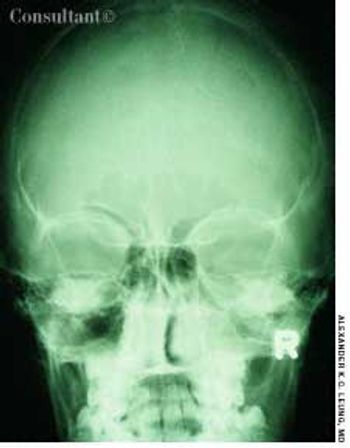
A 10-year-old boy had a headache, fever, cough, and nasal discharge for 2 days. His temperature was 38°C (100.4°F). Mucopurulent, yellow nasal discharge, fetid breath, and tenderness over the maxillary area were noted.
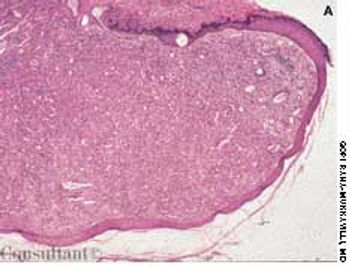
A 32-year-old construction worker sought evaluation of nontender skin lesions that had been erupting for several months. The patient was seropositive for HIV with a CD4+ cell count of 210/µL. He had no history of opportunistic infections.
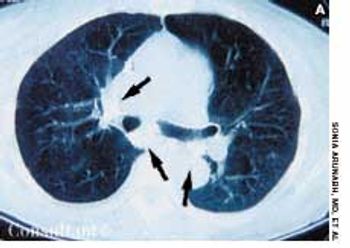
A 72-year-old woman presented for her annual physical examination. She had been treated for tuberculosis 20 years earlier. The patient did not smoke cigarettes; she denied fever, chills, and rigors.
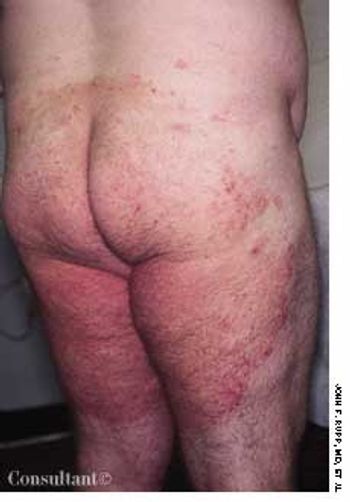
Dermatophyte infections have a predilection for certain anatomic sites, such as the feet, groin, and scalp. Tinea corporis refers to involvement of the trunk and extremities. The condition arises either from direct exposure to an infected source or by extension from an adjacent affected site. Itch is a common symptom, but the intensity of the pruritus can vary from patient to patient.
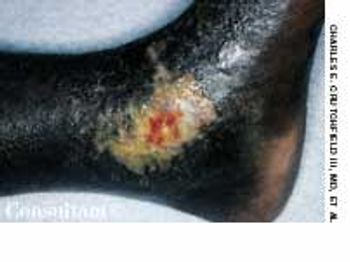
A 39-year-old man who has sickle cell disease suffers with chronic ankle ulcers typical of the disorder. Ulcerations occur in approximately 50% of persons who are homozygous for sickle cell disease.
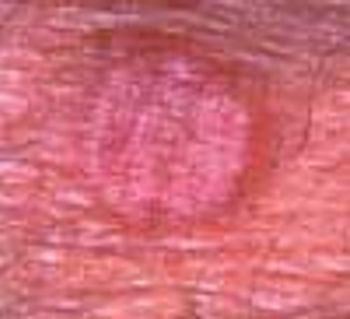
A new lesion recently arose on the right flexor forearm of a 67-year-old man. The 1-cm, pruritic, pink, circular, slightly raised lesion was perfectly homogeneous with no central clearing.